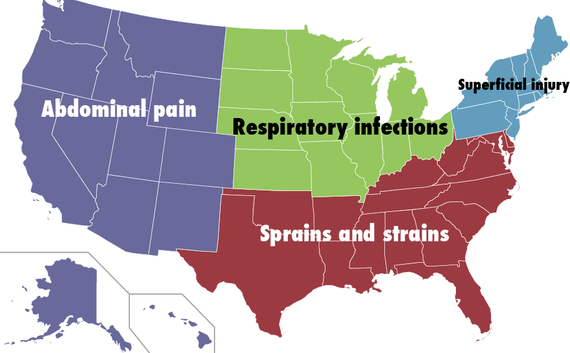

Then, after an average 28-minute wait, the ER doctor will tell you that it's just a contusion, another word for a really bad bruise. Then he'll charge you three times more than your family doctor—or thousands of dollars, if you're uninsured. In the Northeast, this was the most common thing that happened in emergency rooms in 2011.
"The majority of patients with chest pain are going to be fine, but a significant amount could be dead within hours or days."
But each state has its unique boo-boos. As you can see from the map, which I created from new data provided by the Agency for Healthcare Research and Quality, in the South, the most common complaint was a sprain or strain; for the West, it was abdominal pain; and for the Midwest, it was respiratory infections. (Not all states send their ER data to the AHRQ, so the agency lumps them together by region instead.)
For the most part, though, the regional variation means nothing—each region has the same top four complains, just in a different order. And in some cases only a few thousand cases separate the most common complain and the second-most common one.
Instead, it's in the least-common medical conditions that we're likely to see the most variation, says Mark Reiter, president of the American Academy of Emergency Medicine.
"If you're an ER that's near the coast, you're going to see more water-related injuries and illnesses," he said. "In colder climates, you might see frost bite. In warm-weather areas, you might see heat exhaustion, heat stroke, and stuff like that."
Among the more banal aches and pains, there are some true emergencies. Stomachache can be a sign of serious conditions like gall bladder infection or appendicitis. Chest pain could just be anxiety ... or a heart attack.
"The majority of patients with chest pain are going to be fine, but a significant amount could be dead within hours or days," Reiter said.
Family doctors might tell patients to go to the ER if they need a quick-turnaround lab test, CT scan, or another specialized test that few primary care docs can offer but that most hospitals can do in minutes.
At the same time, though, "patients do a poor job of recognizing when they have an emergency," Reiter says. ERs are the right place for new problems, but the absolute wrong place for illnesses that have been lingering for ages.
"If you've had chronic pelvic pain for five years, you're going to get better off seeing the same doctor over time rather than an ER doctor," he says.
More than anything, this map reinforces the 2010 finding that primary-care doctors only handle about 45 percent of cases that require immediate medical attention in the U.S.. Emergency rooms, meanwhile, see 28 percent. That's partly because primary care doctors are now busier than ever, and few can offer weekend, evening, or same-day appointments. In the Netherlands, 95 percent of doctors are able to manage patients after hours without referring them to emergency departments, compared with only 40 percent in the U.S. And of course, uninsured people have few other options than to head to ERs, which are legally mandated to stabilize everyone who walks through the door.
In its paper on ER use, Rand noted that in other countries, general practitioners set up cooperatives to take turns handling patients after hours, and that perhaps the U.S. should look to them as an example if we want to reduce our ER visits. And that's a very nice dream, indeed.



















